Perennial flowers are one of three types of flowers, with the other two being annual and biennial. Perennial flowers are a favorite with gardeners because they bloom year after year. Meaning that as long as you look after them, they reduce your gardening workload and provide wonderful displays of color.
How tall is tall? There is no specific definition. But tall flowers are the ones that you’d choose for the back of borders for architectural height or to fill an unsightly gap. Alternatively, tall flowering plants are often chosen as focal points in containers. They are also a popular choice for small gardens that need to utilize upward space.
Whatever your need, there is a tall perennial flower out there for you and your flourishing garden. We have chosen a wide selection of tall perennial flowers, suiting all types of gardens and locations. So, let’s take a closer look at our favorites.
Agapanthus
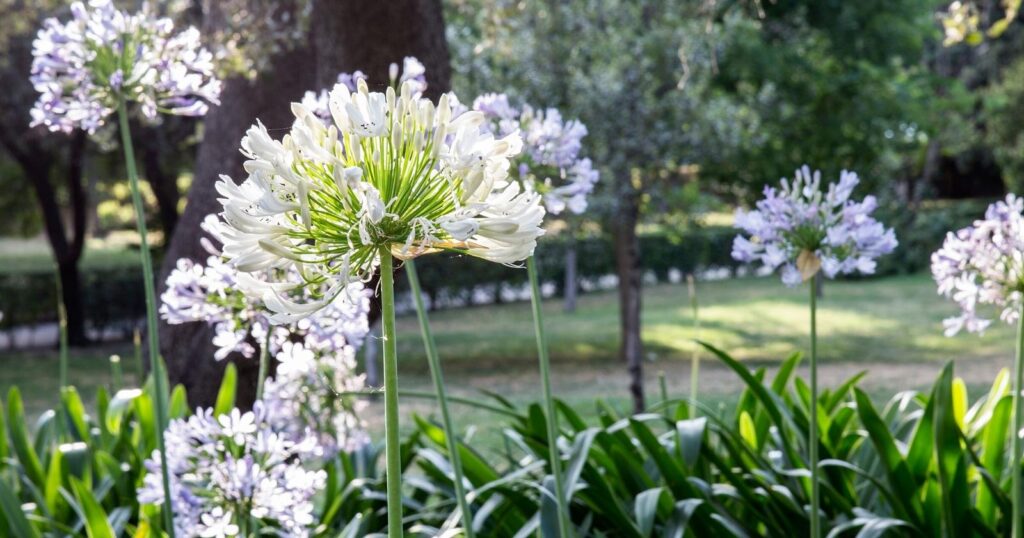
Scientific Name: Agapanthus africanus
- Height When Mature: 2 – 3 feet
- Sun Exposure: Full to partial sun
- Soil pH: Acid, Alkaline, Neutral
- Plant Zone: 8 – 10
Also known as the African Lily, this striking flowering plant produces round clusters of funnel-shaped blooms. Each cluster produces around 40 flowers which sit atop tall thin stems. The perennial blooms are usually purple or blue, although white flowers are also available.
This summer blooming perennial makes an ideal choice for containers, or in ribbons among the flower bed. Agapanthus notably copes well in coastal areas, withstanding windy, salty air. Agapanthus has average water needs and is relatively easy to care for.
Allium
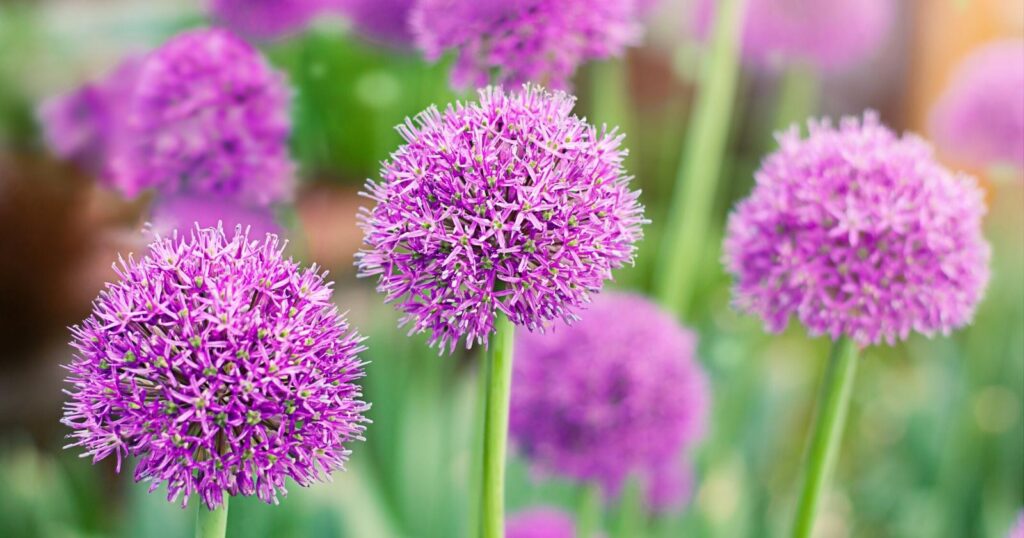
Scientific Name: Allium giganteum
- Height When Mature: 5 – 6 feet
- Sun Exposure: Full sun
- Soil pH: Acid, Alkaline, Neutral
- Plant Zone: 6 – 10
Reaching up to 6 feet tall, this Giant Allium is typically the tallest of the ornamental onions. Tall stems carry a spherical cluster of tiny star-shaped lilac blooms. It blooms in late spring through to early summer, providing a striking ornamental accent.
This Allium is a bulbous perennial that makes a bold statement in any garden, whether at the back of borders or as a focal point. Each bulb produces one stem and one cluster, and they look great when planted in bulk for a dramatic statement. It has average water needs and is generally low maintenance making it a top perennial choice.
Baptisia
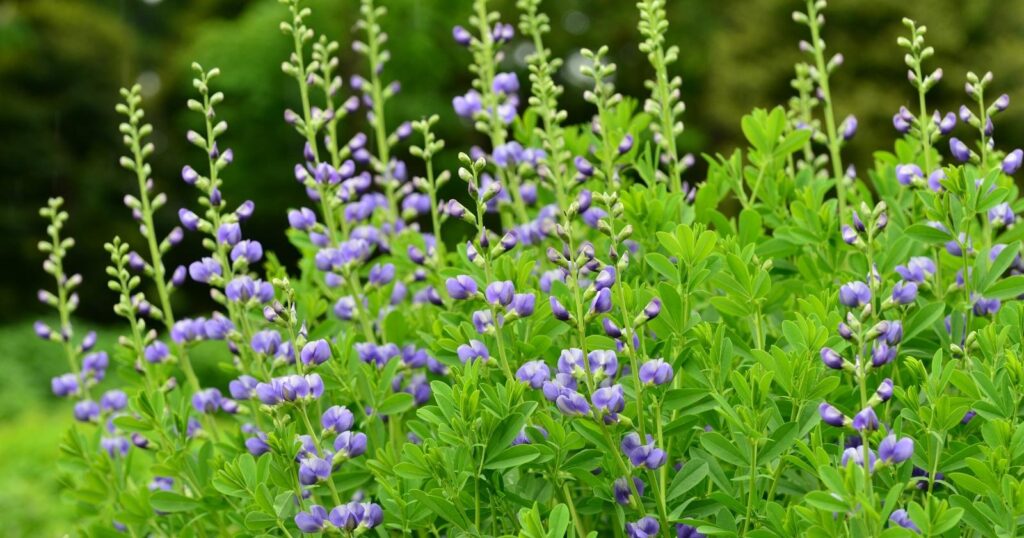
Scientific Name: Baptisia australis
- Height When Mature: 3 – 4 feet
- Sun Exposure: Full sun
- Soil pH: Acid, Neutral
- Plant Zone: 3 – 9
Commonly known as the False Indigo, this perennial flower provides striking upright flowers for three weeks. It produces spikes of pea-shaped blue and indigo blooms, often being confused for Lupines.
After this Baptisia continues to provide a pretty foliage background for other perennials in the bed. It also produces intense black seedpods in the fall for seasonal interest and makes delightful dried flower decorations. It has low to average water needs and can tolerate poor soils. Plant this tall perennial in small batches, and it’ll give a lot to any garden.
Bear’s Breech
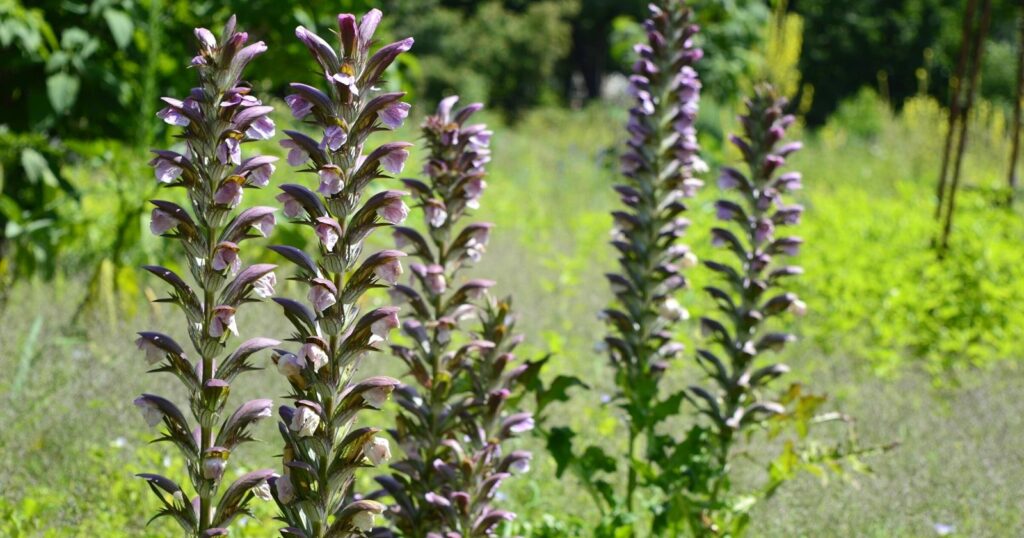
Scientific Name: Acanthus mollis
- Height When Mature: 3 – 5 feet
- Sun Exposure: Full to partial sun
- Soil pH: Acid, Alkaline, Neutral
- Plant Zone: 7 – 11
The Acanthus mollis is one of the tallest Bear’s Breeches. It produces grand spikes of creamy-white hooded flowers decorated with purple bracts. The evergreen foliage is thick, shiny, and very attractive.
This flower is simple to establish, requires little maintenance, and it has average water needs. Bear’s Breech produces elegant blooms and architectural height year after year, making it a wonderful addition to any well-dressed or Mediterranean garden.
Beehive Ginger
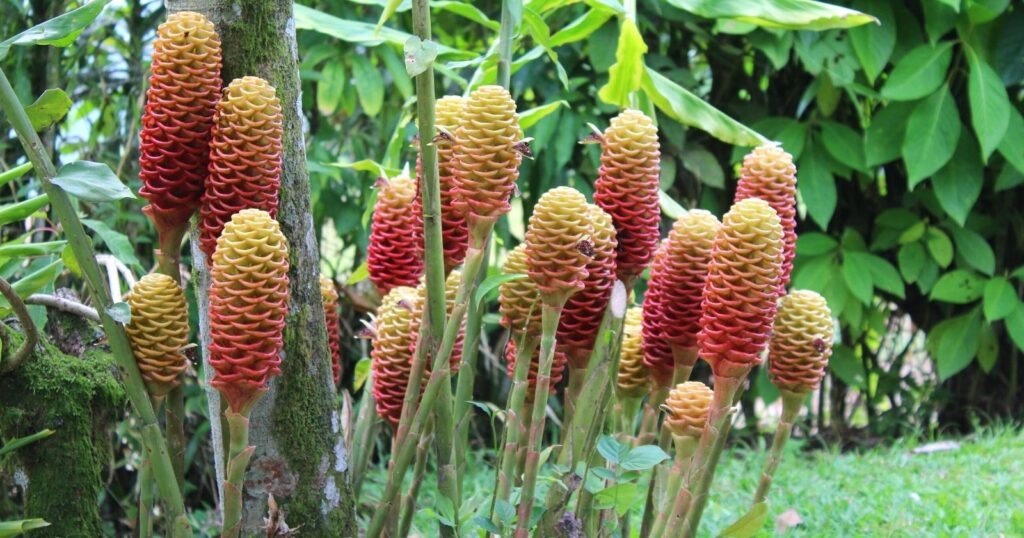
Scientific Name: Zingiber spectabile
- Height When Mature: Up to 8 feet
- Sun Exposure: Full to partial sun
- Soil pH: Acid, Alkaline, Neutral
- Plant Zone: 9 – 11
Beehive Ginger is named because it looks like a beehive and can be used in cooking as an alternative to common ginger. This fun plant produces green bracts which gradually transform into bright red and yellow pinecones. For an extra quirkiness, small white and purple flowers bloom from the ridges.
This tropical-looking perennial is native to hot and humid areas, so it needs moist conditions to thrive. Elsewhere it should be grown in containers and may need to be taken indoors or into a warm greenhouse. When cared for properly, it delivers a colorful perennial punch to any outdoor space.
Bigleaf Lupine
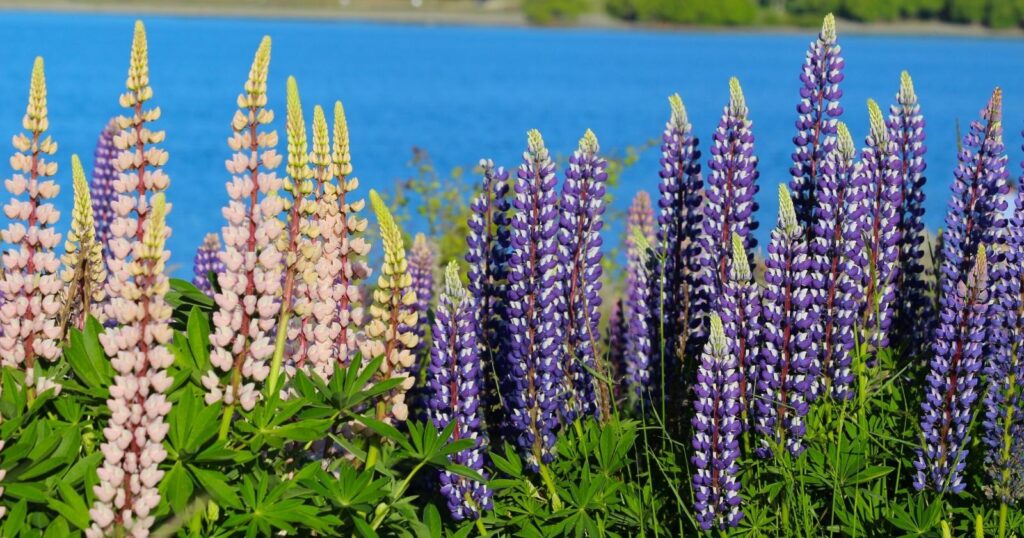
Scientific Name: Lupinus polyphyllus
- Height When Mature: 3 – 5 feet
- Sun Exposure: Full sun
- Soil pH: Acid, Neutral
- Plant Zone: 3 – 6
This sturdy herbaceous perennial has large palm-like leaves that are rich-green in color. The foliage gives way to tall and densely packed clusters of deep blue and purple pea-shaped flowers. This Lupine is stunning when planted en masse and provides a sea of intense color.
It is a low-maintenance plant that requires little to average water. But it does well in moist conditions. It is deer resistant, and bees, butterflies, and other pollinators love it too. Just be wary because it is toxic when ingested, especially the seeds.
Boltonia
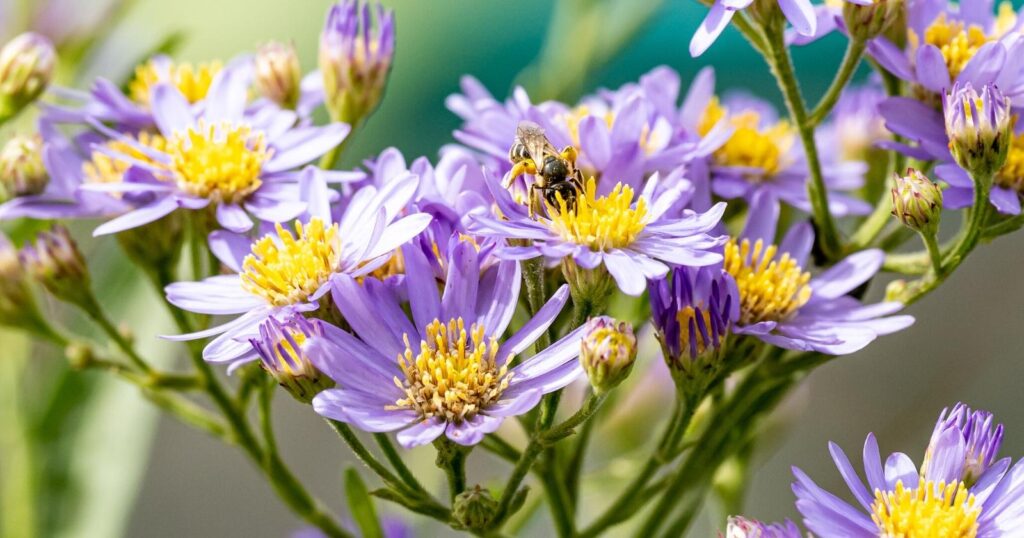
Scientific Name: Boltonia asteroides
- Height When Mature: 5 – 6 feet
- Sun Exposure: Full sun
- Soil pH: Acid, Neutral
- Plant Zone: 3 – 10
The False Aster is a rhizomatous perennial that produces a mass display of small daisy-like blooms. Despite the small blooms, the plant is covered in them, making it a popular addition to any flowering garden. It blooms in late summer, adding late interest and color. The flowers are predominantly white, sometimes with pink, purple, or blue hues.
This native North American perennial offers gardeners a lot considering that it has low to average water needs, can tolerate many soil types and is generally easy to care for. If you select this tall perennial flower, butterflies and bees will flock to your yard.
Butterfly Bush
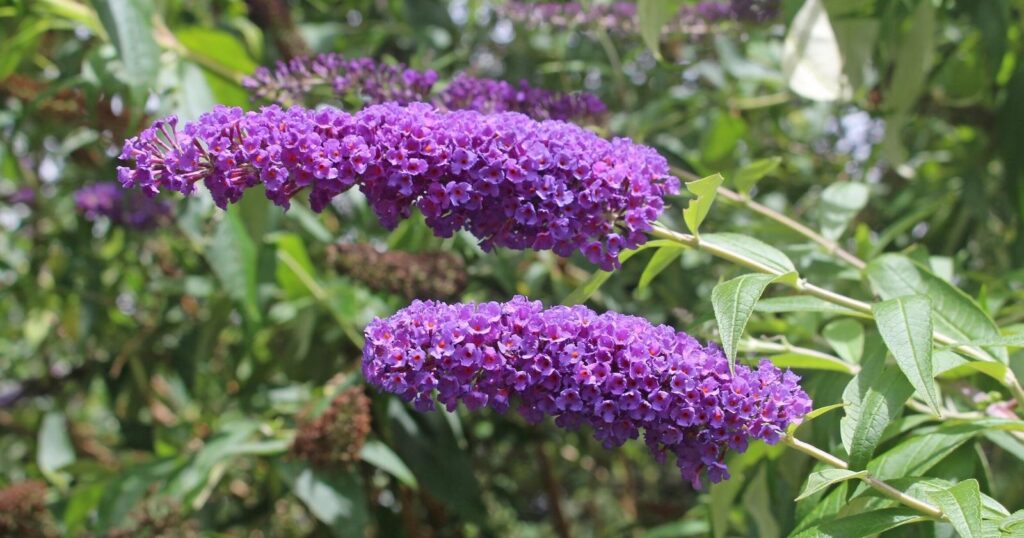
Scientific Name: Buddleja davidii
- Height When Mature: Up to 12 feet
- Sun Exposure: Full sun
- Soil pH: Acid, Alkaline, Neutral
- Plant Zone: 5 – 9
The Butterfly Bush is a perennial shrub that is invasive in many parts of the U.S. However, when controlled properly, it is a delightful deciduous option for most landscapes. Bear in mind that it can grow as wide as it does tall, so you’ll need to prune it to shape. Aside from this, they are very low maintenance and provide loads of benefits.
There are over 160 cultivars of Butterfly Bush to choose from. Most Buddlejas are purple, blue, pink, or white, with some sporting a mixture of colors. As you might expect, this tall perennial attracts butterflies and other pollinators. Buddlejas provide a terrific backdrop for perennial gardens.
Canna
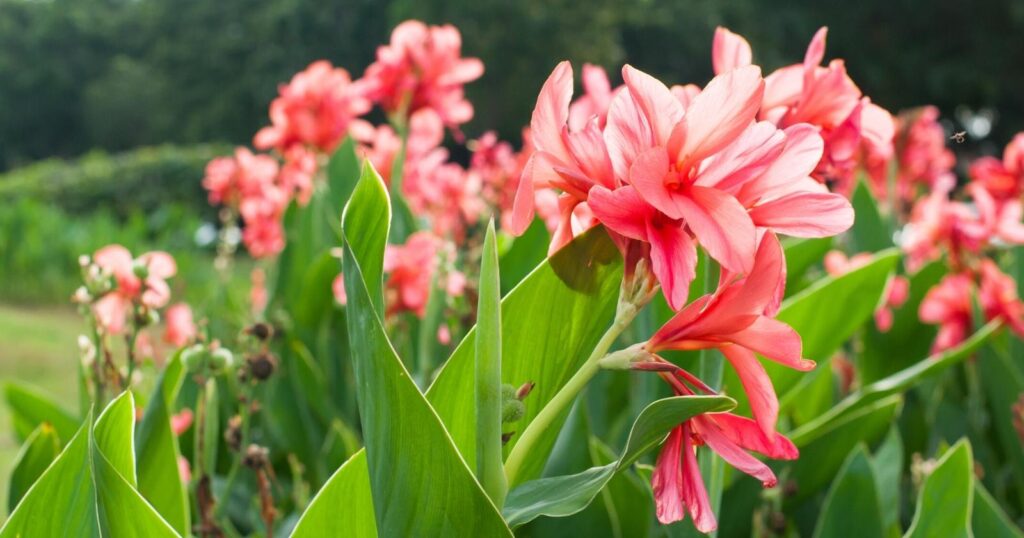
Scientific Name: Canna indica
- Height When Mature: Up to 8 feet
- Sun Exposure: Full sun
- Soil pH: Acid, Alkaline, Neutral
- Plant Zone: 8 – 11
Cannas are related to bananas, which is why the foliage looks like banana tree leaves. The foliage itself is attractive, but the bloom is the star of the show. Cannas bloom perennially in red, orange, and yellow, this tall perennial flower will deliver a fiery warmth to your garden. The flowers sit atop erect stems that rise above the foliage.
This tall bulbous perennial has average to high water needs and needs a generous supply of water in the summer. However, it is almost completely tolerant of pests and disease, making it low maintenance. Cannas look awesome when planted along a fence or in a standalone container as a showstopper.
Common Foxglove
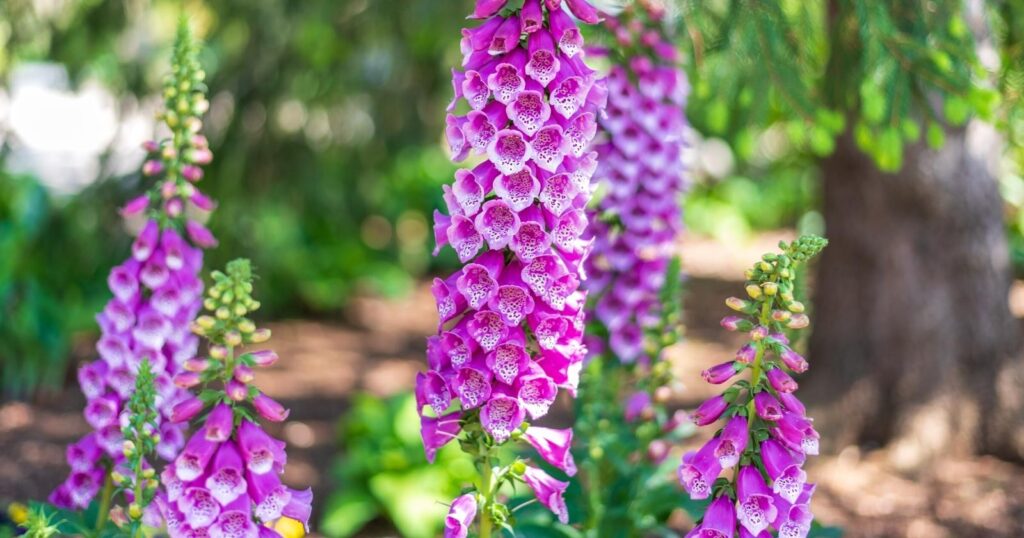
Scientific Name: Digitalis purpurea
- Height When Mature: 3 – 5 feet
- Sun Exposure: Full to partial sun
- Soil pH: Acid, Alkaline, Neutral
- Plant Zone: 4 – 8
The Common Foxglove is a gardener’s favorite. It is perfect for any garden looking for elegance and a pop of color. Also known as Fairy Bells, the flowers are pink to purple with beautiful white spotted throats. Butterflies, bees, and hummingbirds adore this tall perennial flower. It has average water needs and prefers humus-rich soil.
However, the Common Foxglove is also considered a biennial. Meaning that it is shorter-lived than most of the other tall perennials on this list. With that being said, it self-sows freely, meaning that colonies should return year after year. Always wear gloves when handling Foxgloves as they are toxic.
Crocosmia
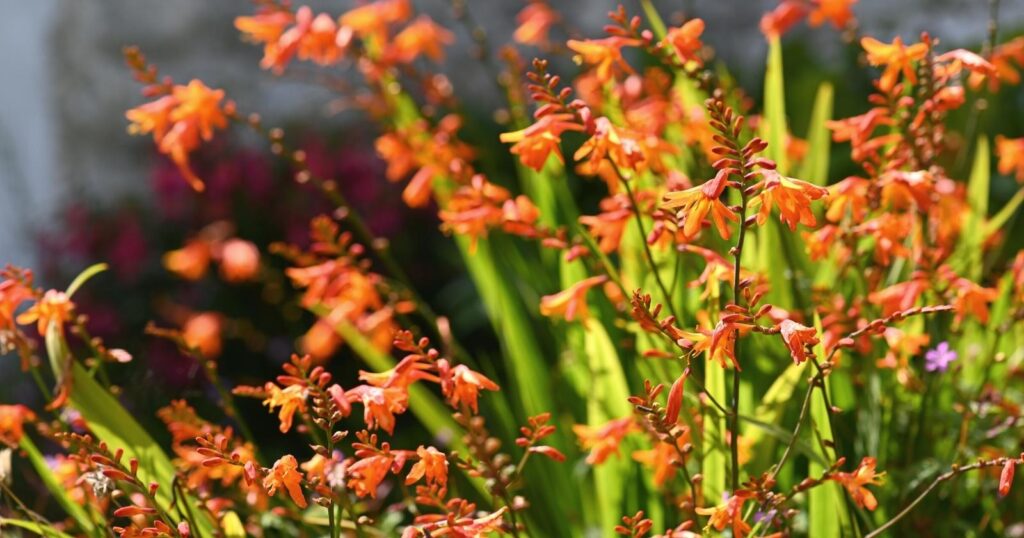
Scientific Name: Crocosmia masoniorum
- Height When Mature: 4 – 5 feet
- Sun Exposure: Full to partial sun
- Soil pH: Acid, Alkaline, Neutral
- Plant Zone: 6 – 9
Also known as the Giant Montbretia, this bulbous flowering plant is a late perennial bloomer. Meaning that when most other perennials fade, the Crocosmia comes to life. Providing gardens with one last vibrant color injection. The flowers on this showy option face upward sat on tall arching stems.
The foliage is tall and sword-like, providing extra vertical shapes in beds and borders. Plant Crocosmia in groups of 10 or more for an outstanding show of orange flames. It is a native South African flower with average water needs but needs moist and rich soils to thrive.
Cutleaf Coneflower
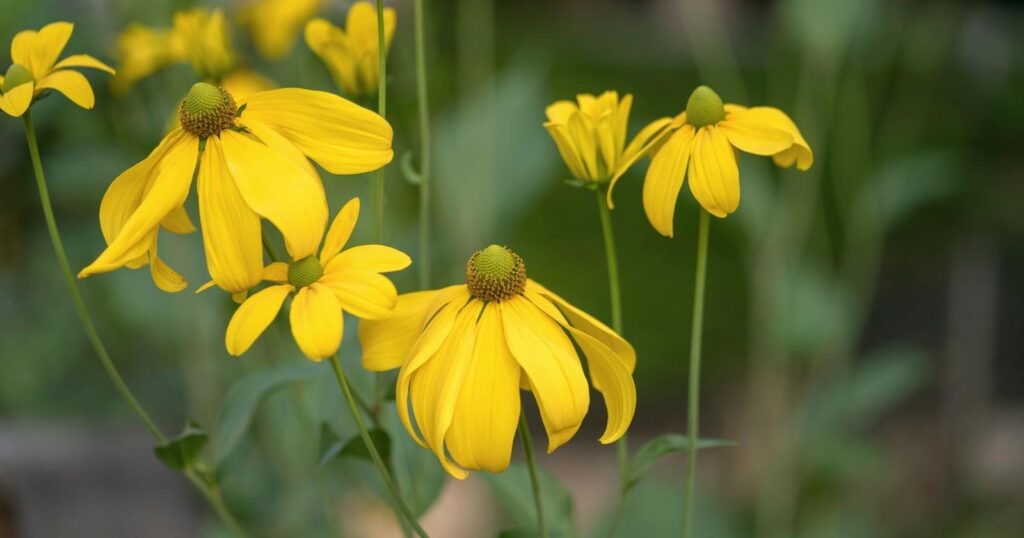
Scientific Name: Rudbeckia laciniata
- Height When Mature: 3 – 9 feet
- Sun Exposure: Full to partial sun
- Soil pH: Acid, Alkaline, Neutral
- Plant Zone: 3 – 9
The Cutleaf Coneflower is one of the tallest Coneflowers, making it ideal for gardeners seeking elevated daisies. The domed centers are green and surrounded by brightly colored yellow petals. It is a late bloomer that blossoms in midsummer through to mid-fall. The seedheads also provide seasonal interest and food for birds.
This Coneflower requires more water than the average perennial flower, but it does not suffer from many pests or diseases. It is easy to establish, however, it is rhizomatous and spreads very quickly. Making it more popular in larger gardens or vast landscapes.
Delphinium
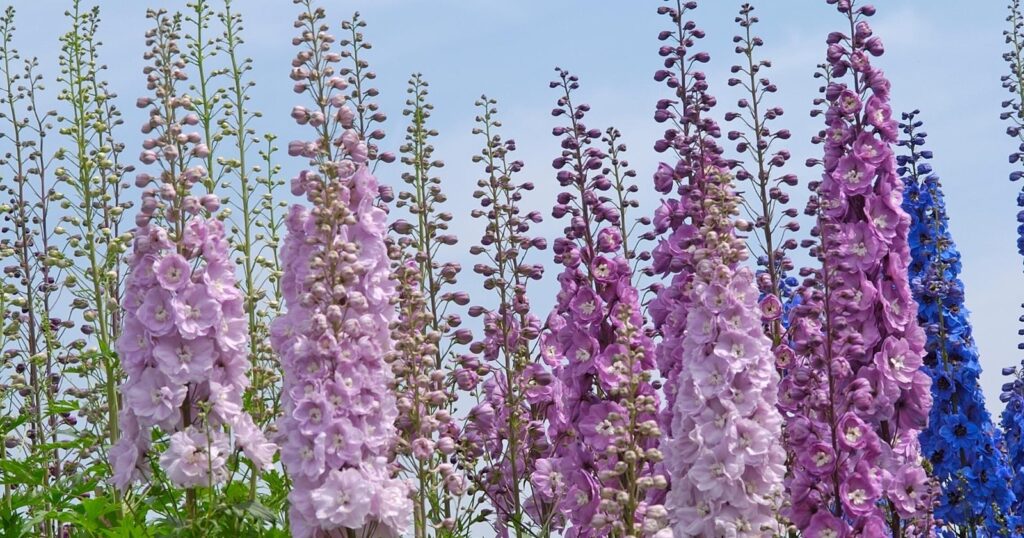
Scientific Name: Delphinium elatum
- Height When Mature: 4 – 6 feet
- Sun Exposure: Full sun
- Soil pH: Acid, Alkaline, Neutral
- Plant Zone: 3 – 7
Also known as Candle Larkspur, this is an elegant but robust perennial flower. The tops of the tall stems are densely bejeweled with rose pink flowers. It is long blooming from summer through to fall and provides a pop of color above other shorter perennials. Plant in groups and you’ll achieve a delicate display of soft, fluffy texture and color.
Delphinium attracts pollinators which is great for a wildlife garden. But like the Foxglove, they are toxic so handle them with care. Although the stems are strong, they are also top-heavy, so keep them sheltered from the wind.
Foxtail Lily
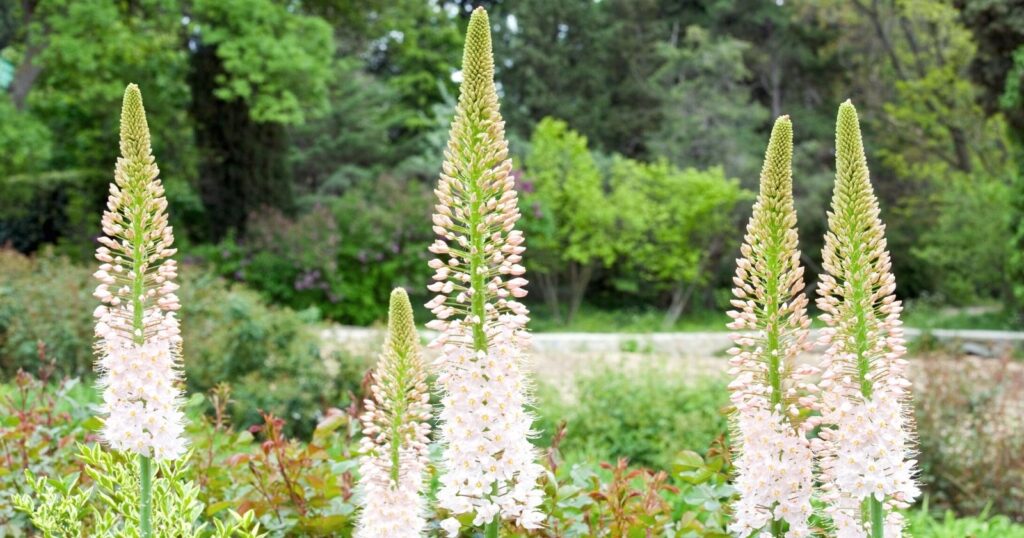
Scientific Name: Eremurus robustus
- Height When Mature: 5 – 10 feet
- Sun Exposure: Full sun
- Soil pH: Acid, Alkaline, Neutral
- Plant Zone: 5 – 8
The Foxtail Lily, sometimes known as the Giant Desert Candle, is one of the tallest perennial flowers out there. Tall stalks carry up to 800 tiny flowers, all peachy pink in color with contrasting orange stamens. Each cone of blooms opens gradually, providing several weeks of color.
The Foxtail Lily returns year after year requiring little maintenance and average water, and it also naturalizes well. Butterflies and Hummingbirds are drawn to this flower, and thankfully deers and other critters cannot reach the blooms. Each bulb produces one stalk, so be sure to plant a handful of bulbs for the best visual impact.
Giant Himalayan Lily
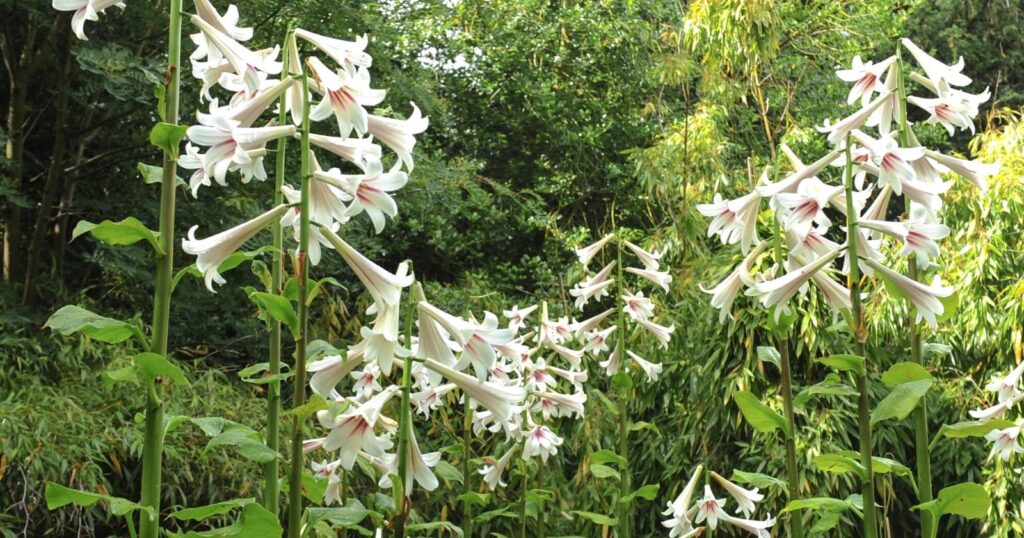
Scientific Name: Cardiocrinum giganteum
- Height When Mature: 7 – 9 feet
- Sun Exposure: Partial sun
- Soil pH: Acid, Alkaline, Neutral
- Plant Zone: 7 – 9
Selecting this tall perennial flower will deliver one of nature’s most dazzling flower displays. And if you are a Lily fan, you’re bound to love this option. However, it has a reputation for being a high-maintenance flower. It can take up to seven years to flower from a bulb (4 – 5 years from an offset), but the wait will be worth it. Like most Lilies, they are highly fragrant too.
The Giant Himalayan Lily requires partial shade and moist but well-drained soil. If you are going to take on the challenge of this perennial flower, you should plant several of them for a breathtaking display. The stems reach up to 9 feet tall, each carrying up to 20 trumpet-shaped white glossy flowers with contrasting purple throats.
Giant Viper’s Bugloss
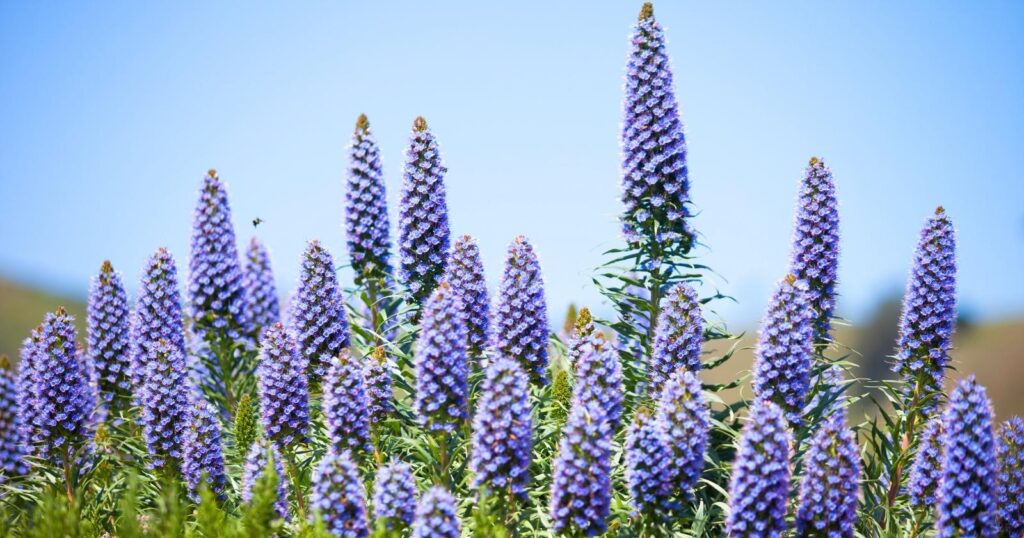
Scientific Name: Echium pininana
- Height When Mature: 15 – 18 feet
- Sun Exposure: Full sun
- Soil pH: Acid, Alkaline, Neutral
- Plant Zone: 8 – 10
This dramatic perennial flower is the highest on this list. So if you’re seeking taller than tall vertical lines for your garden, this could be the best pick. Aptly named the Tower of Jewels, it holds thousands of small white or blue flowers. Bees cannot get enough of this elevated flower-packed missile.
It is a short-lived full sun perennial, but thankfully it self-seeds easily, maintaining its presence. It is native to the Canary Islands and it requires little water compared to other perennials. Not only is it striking, but it is also relatively undemanding, making it a top choice for gardeners.
Goat’s Beard
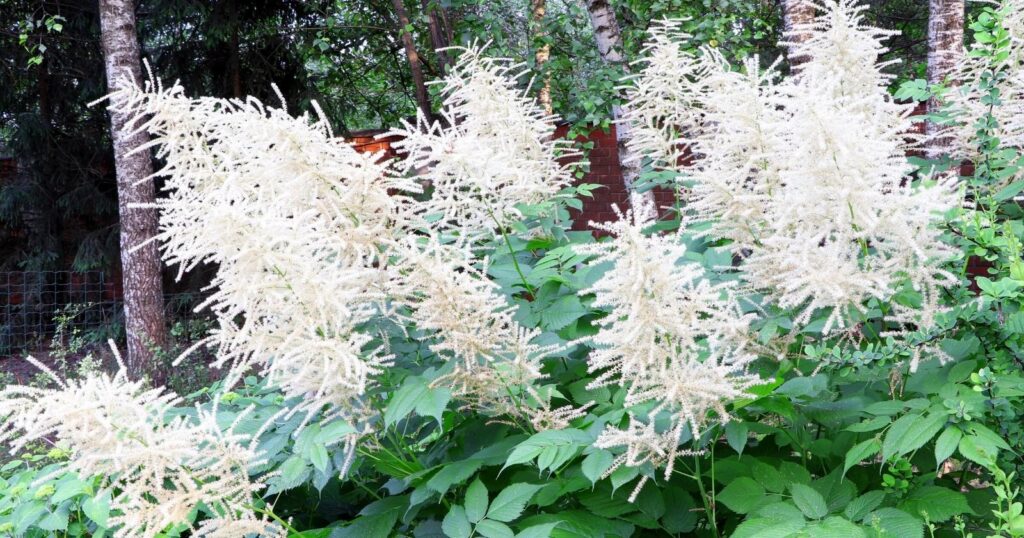
Scientific Name: Aruncus dioicus
- Height When Mature: 4 – 6 feet
- Sun Exposure: Full to partial sun
- Soil pH: Neutral
- Plant Zone: 3 – 9
Here we have a delicate-looking perennial shrub. It produces feathery plumes of tiny flowers. The flowers are creamy-white standing out against the dark green foliage. Goat’s Beard blooms from early to mid-summer.
This popular plant has high water needs and does well in water gardens or alongside streams. Goat’s Beard holds its male and female reproductive organs on separate plants. Male plants are notably more attractive than female plants as they carry more flowers.
Gunnera
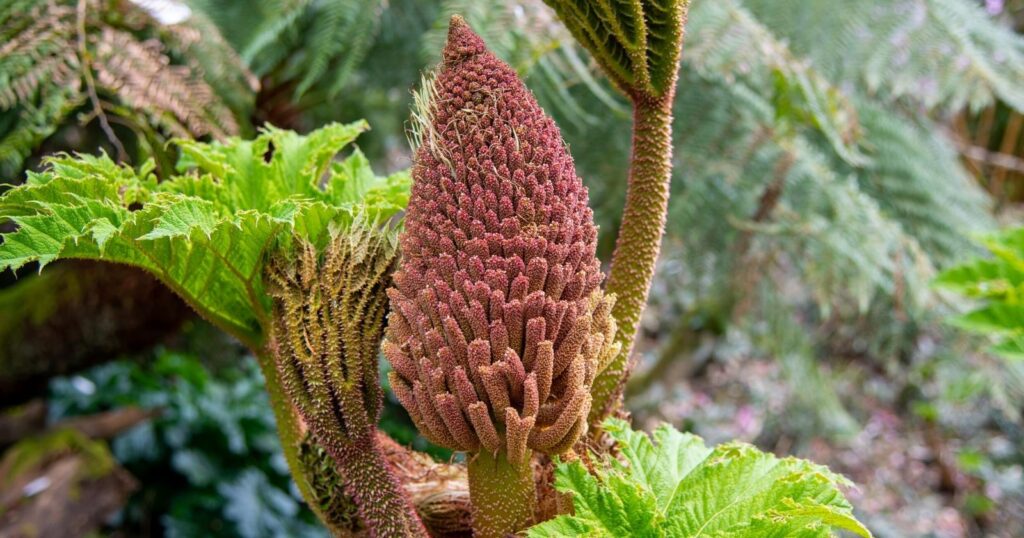
Scientific Name: Gunnera manicata
- Height When Mature: 6 – 10 feet
- Sun Exposure: Full to partial sun
- Soil pH: Acid, Alkaline, Neutral
- Plant Zone: 7 – 10
Gunnera commonly goes by the name of Giant Rhubarb, and it’s easy to see why. However, most advise against eating it. Most gardeners plant it for its spectacular ornamental presence, which is why it has earned the nickname Dinosaur food. It grows wider than it does tall (measuring up to 14 feet across) so be sure to give it space.
In the summer it produces giant conical panicles with red and green florets. It has high water needs and does exceedingly well in water gardens or alongside streams. It is native to Brazil and it is relatively low maintenance.
Hardy Hibiscus
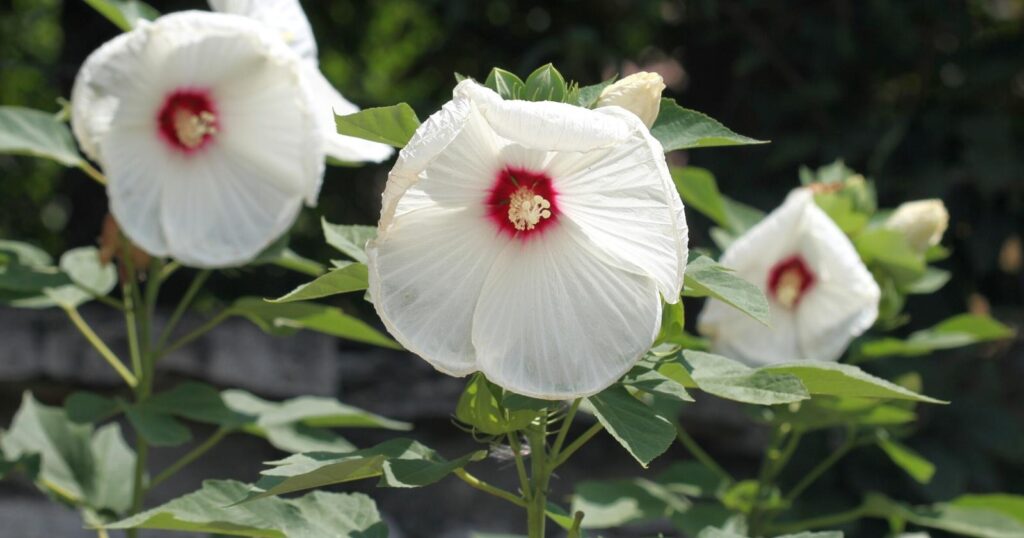
Scientific Name: Hibiscus moscheutos
- Height When Mature: 3 – 7 feet
- Sun Exposure: Full sun
- Soil pH: Acid, Alkaline, Neutral
- Plant Zone: 5 – 9
Also known as Rose Mallow, this is a delicately tall perennial shrub. It provides an abundance of striking white, rose, or pink blooms with a contrasting red center. It blooms abundantly from midsummer through to the first frost, and a large plant can provide 20 blooms every day.
This woody shrub likes medium to wet soils. It can also be grown in standing water up to 6 inches, making it an ideal pond or stream companion.
Hollyhock
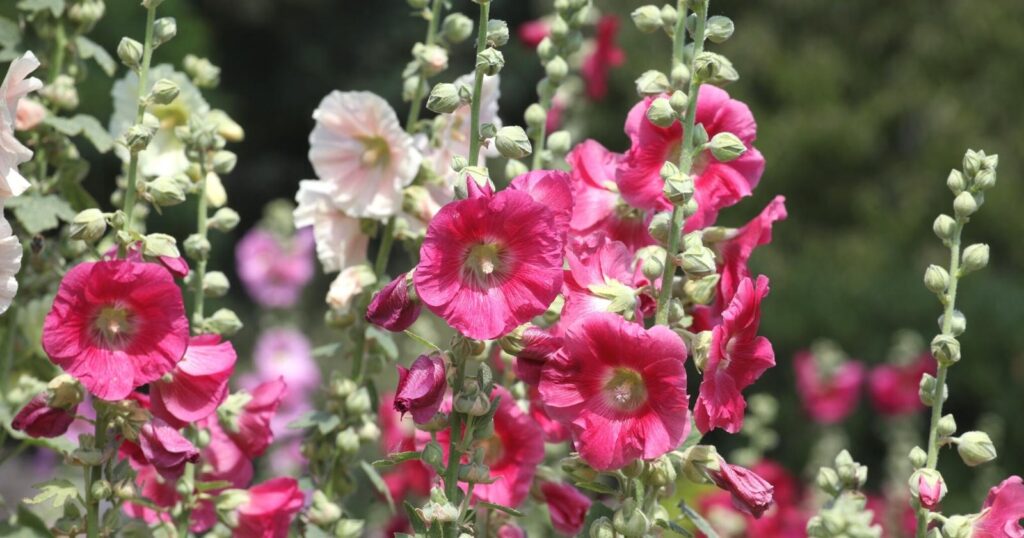
Scientific Name: Alcea rugosa
- Height When Mature: 4 – 6 feet
- Sun Exposure: Full sun
- Soil pH: Acid, Alkaline, Neutral
- Plant Zone: 3 – 7
The Hollyhock is a short-lived perennial, however, it self-seeds easily allowing it to maintain its spot in the garden. It provides gardeners with pretty rose-like blooms that can be seen from far away thanks to its height. The delicate flowers are funnel-shaped and pale yellow.
Hollyhocks look great against a wall or a fence, just be sure to protect them from the wind as they are not particularly sturdy. Alcea rugosa blooms from late spring to late summer and it has average watering needs.
Maximilian Sunflower
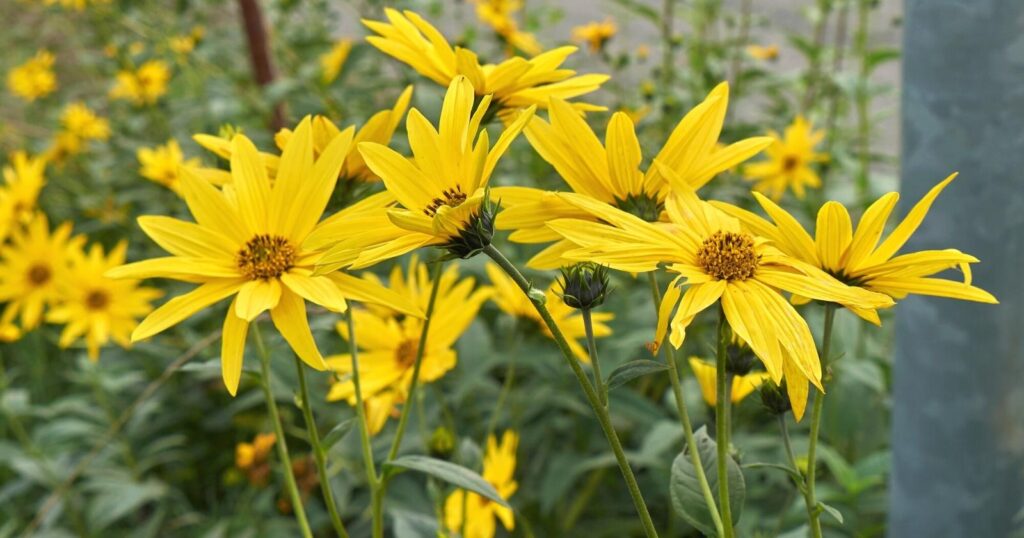
Scientific Name: Helianthus maximiliani
- Height When Mature: 3 – 10 feet
- Sun Exposure: Full sun
- Soil pH: Acid, Alkaline, Neutral
- Plant Zone: 4 – 9
Sunflowers are prized for their bright yellow color and cheerful beauty. The Maximilian Sunflower is tall thanks to its rigid and fuzzy stems. The flowers measure up to 3 inches across with a darker center.
The Sunflower is a valuable flower in any wildlife garden and will attract pollinating insects and birds from afar. It has low to average watering needs and will return yearly blooming during late summer. This option needs room to spread its Sunflower wings, so be sure to give it the space it needs.
Pineapple Sage
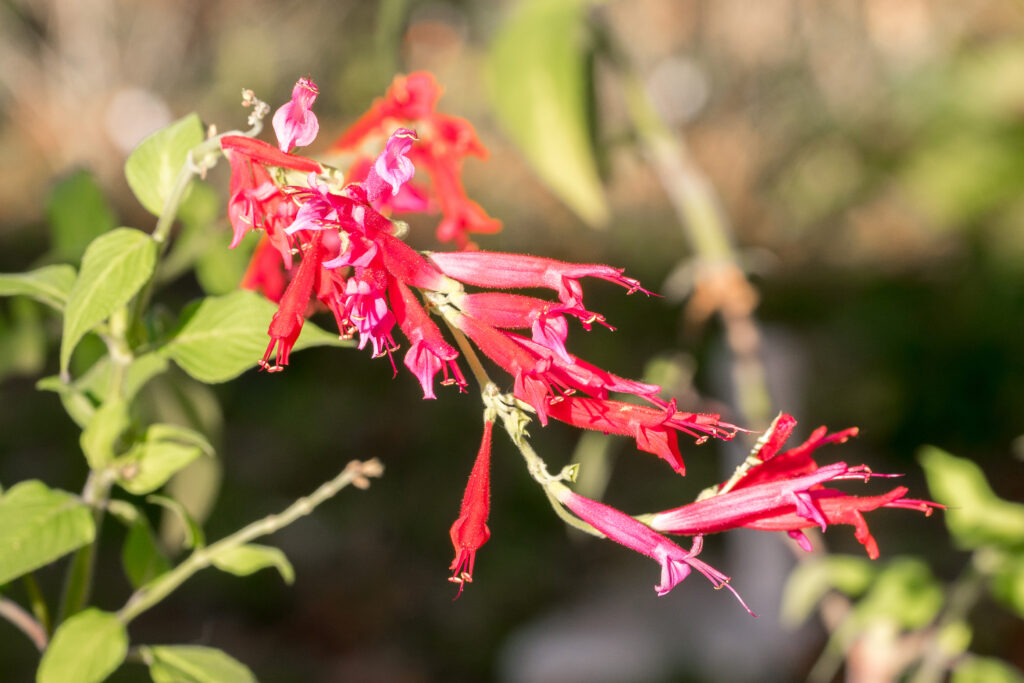
Scientific Name: Salvia elegans
- Height When Mature: 4 – 5 feet
- Sun Exposure: Full to partial sun
- Soil pH: Acid, Alkaline, Neutral
- Plant Zone: 8 – 11
Pineapple Sage is one of the most popular Salvias, and for many reasons. It is tall and showy, adding vertical interest. The fun flowers are tubular and bright red, sitting on top of long spikes. The reason this perennial shrub is called Pineapple Sage is that the foliage smells just like pineapple. A welcome addition to any garden!
Pineapple Sage blooms from late summer through to the first frost, extending the summer season. In some warmer climates, it can bloom through to the spring. It is low maintenance but requires moist (but well-drained) soil to flower. This is a Hummingbird favorite.
Plume Poppy
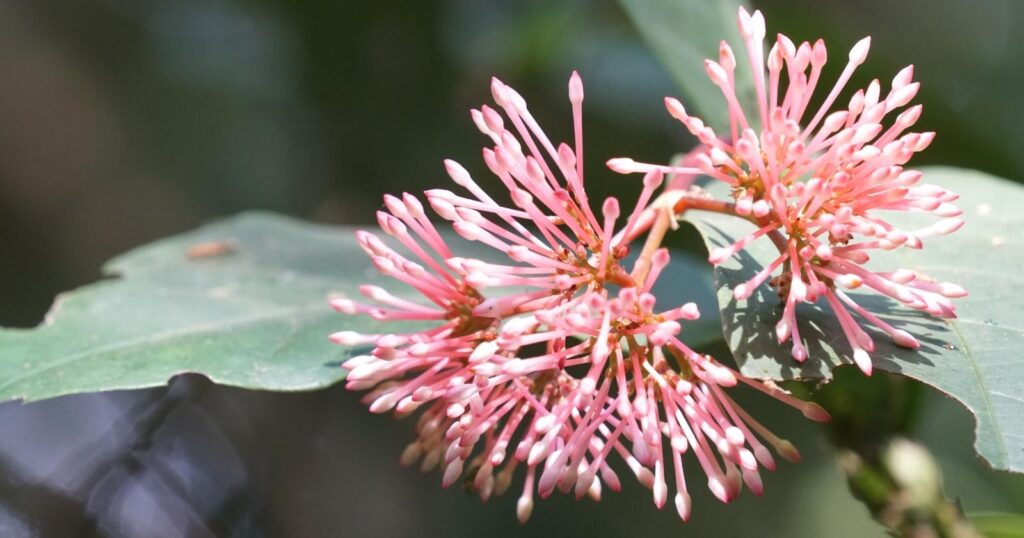
Scientific Name: Macleaya microcarpa
- Height When Mature: 6 – 8 feet
- Sun Exposure: Full to partial sun
- Soil pH: Acid, Alkaline, Neutral
- Plant Zone: 4 – 9
Plume Poppy is an energetically spreading perennial plant that is ideal for adding heights to borders. It produces fluffy-like pannicles of tiny coral pink flowers. The foliage is gray-green with white undersides. Both the flowers and leaves are ideal for cutting and drying arrangements.
Plume Poppy stays in bloom from summer to fall. It is slow to establish, but once it is it grows quickly. It is a low-maintenance option that tolerates most soils. If you’re seeking, height, texture, and color from an easy perennial flower, look no further.
Queen of the Prairie
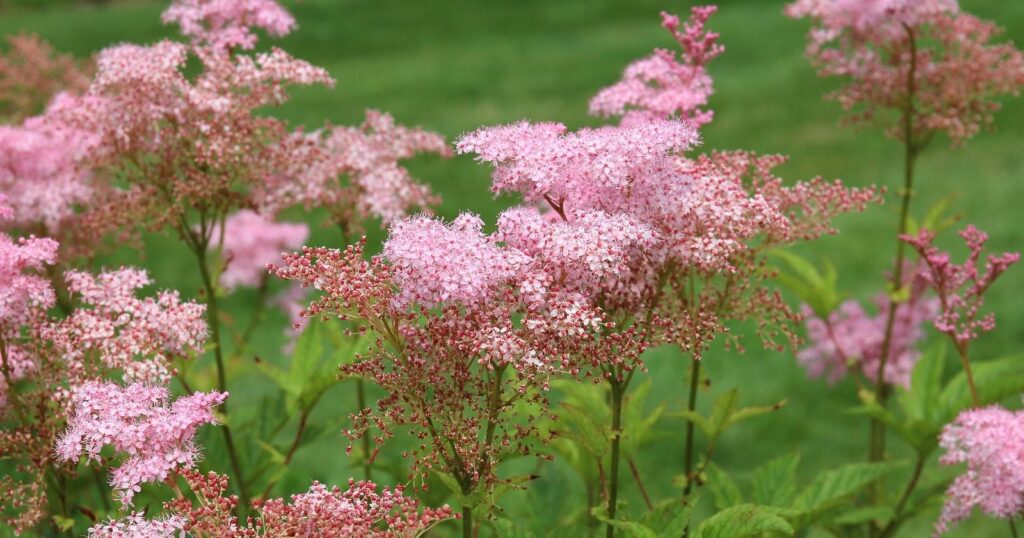
Scientific Name: Filipendula rubra
- Height When Mature: 6 – 8 feet
- Sun Exposure: Full to partial sun
- Soil pH: Acid, Alkaline, Neutral
- Plant Zone: 3 – 9
Also known as Meadowsweet, this native American perennial is prized for its foliage and flowers. It is a tall herbaceous plant with an upright habit. The slender stems give way to clusters of delicate pink flowers that bloom from early to late summer. It is highly fragrant and looks a lot like candyfloss.
Queen of the Prairie self-seeds and spreads quickly, forming large colonies if left to its own devices. Although it is low maintenance, it is intolerant to drought so be sure to keep the soil moist but well-drained. It does well in almost any type of garden making it a popular choice with gardeners.
Sneezeweed
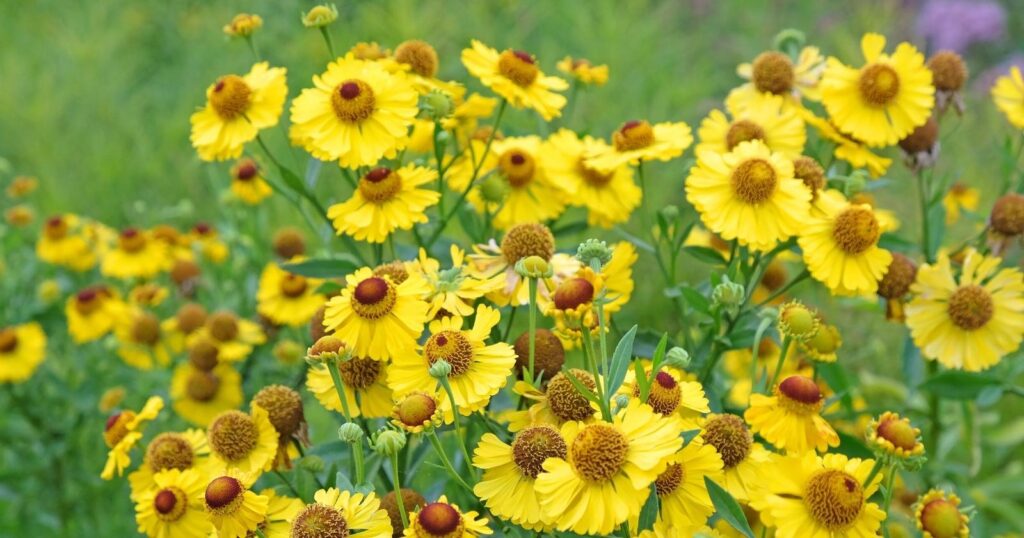
Scientific Name: Helenium
- Height When Mature: 3 – 5 feet
- Sun Exposure: Full sun
- Soil pH: Acid, Alkaline, Neutral
- Plant Zone: 3 – 8
This tall perennial flower is native to North and Central America. It is a late bloomer, meaning it extends your garden’s color into the colder months. Deadhead and water regularly to promote blooms. The daisy-like flowers come in many colors, including hot reds through to bright yellows.
Sneezeweed is great for pollinating wildlife, and the seeded center will provide seeds for birds in the winter too. Interestingly, it is called Sneezeweed because its dried leaves were used to make snuff. Allowing humans to inhale it and rid themselves of evil spirits.
Sweet-Scented Joe Pye Weed
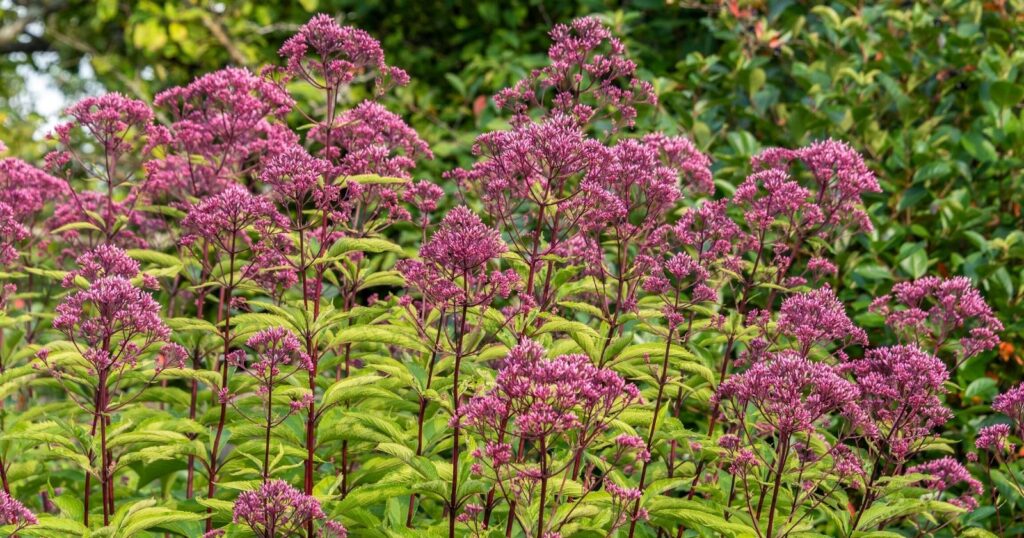
Scientific Name: Eutrochium purpureum
- Height When Mature: 5 – 7 feet
- Sun Exposure: Full to partial sun
- Soil pH: Acid, Alkaline, Neutral
- Plant Zone: 3 – 9
Many gardeners know about Joe Pye Weed, but not everyone knows about the taller, vanilla-scented variety. And thankfully, it is a low-maintenance option that packs a punch in a perennial border.
This perennial flower is prized for its outstanding clusters of pink flowers, measuring 12 to 18 inches across. Wildlife gardens treasure this plant as it is a great source of honey for pollinators. After the bloom period seedheads follow, supplying food for the birds throughout the colder months.
Tall Verbena
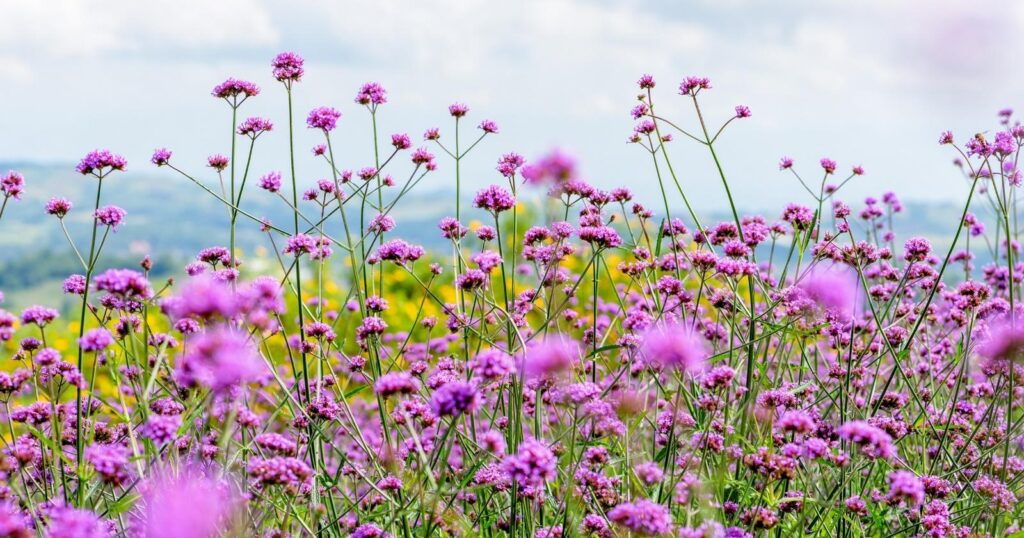
Scientific Name: Verbena bonariensis
- Height When Mature: 3 – 6 feet
- Sun Exposure: Full sun
- Soil pH: Acid, Alkaline, Neutral
- Plant Zone: 7 – 11
Last but not least we fittingly finish with Tall Verbena. It is a slender plant that offers a multi-directional display of compact flower clusters. The blooms are rich lilac and act as a magnet to pollinators and birds. It is an easy-going plant that requires little input, and it has average water needs.
Tall Verbena is long-blooming and reaches heights of 6 feet very quickly. This is great if you need tall perennials fast! Plus, their see-through habit means that you can plant them anywhere in the garden, not just at the rear like most other tall perennials.
Wrap Up
Designing a landscape can be a tough job. But if it’s a tall perennial flower, or a few, that you’re after, we’ve got you covered. This list includes some of the most spectacular tall perennial flowers for your flower garden. From lofty Lupines to high Hollyhocks, whatever your need or design, there is something here for everyone.

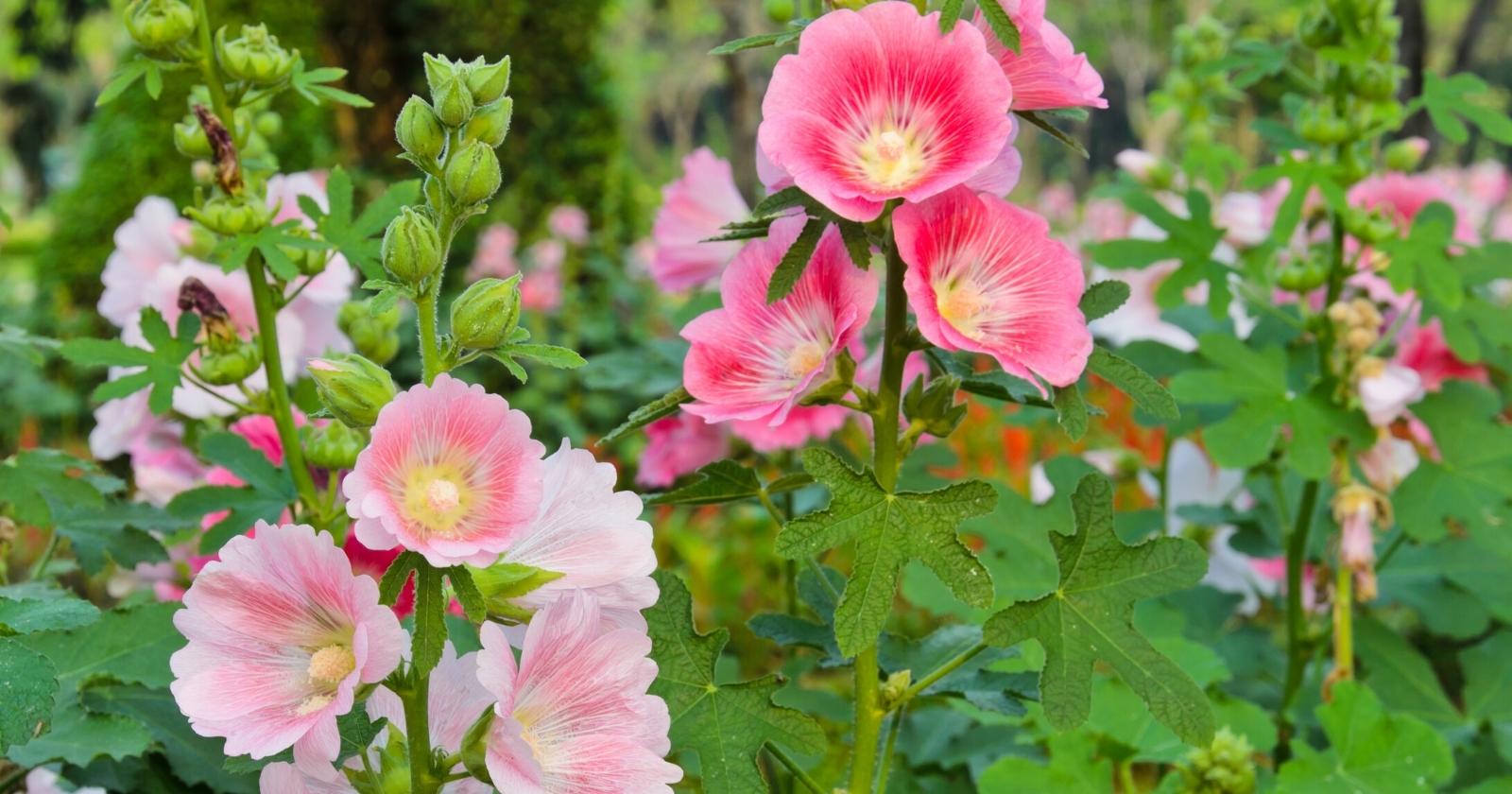
Leave a comment